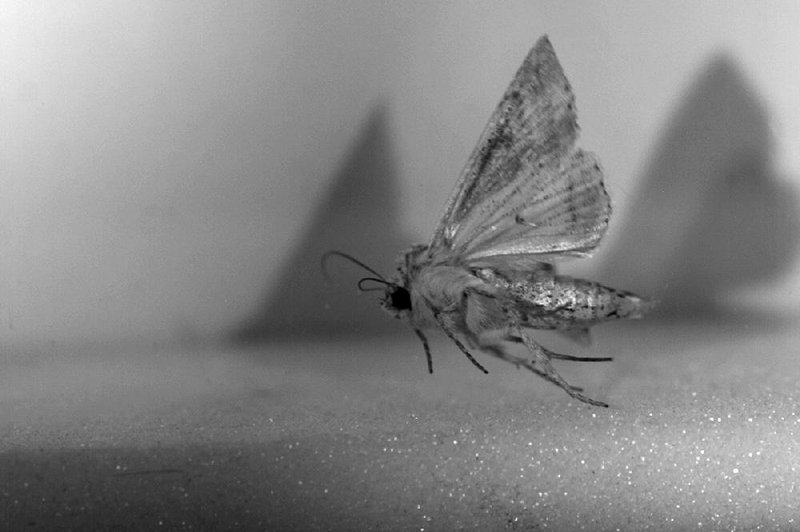Moths often have relatively large wings, which can pose a problem as they take off. The wings might thrash against a leaf or the ground.
So, they jump. Or, to borrow a phrase that the poet ee cummings used to describe the kingbird, they "leap upon the air."
The lightest moths sometimes don't open their wings at all, satisfied with a hop and then another hop and so on. Others open them only when fully airborne.
Medium-size moths are more likely to start off with a jump but open their wings immediately to start powered flight. Heavier moths are more likely to use yet another strategy, opening their wings first so that with a downbeat they can use wing and leg power to lift off.
The heaviest moths of all may have to depend almost entirely on their wings. But Malcolm Burrows and Marina Dorosenko of the University of Cambridge in Britain did not include them among the 58 kinds of moths they recorded with high-speed video. Their findings, including the news that moths jump, were reported April 16 in The Journal of Experimental Biology.
But so what? What good is it to know that moths jump?
One answer is that the movements of zippy little creatures with small brains will help in the design of zippy little flying robots, with small computers for brains. And it may well, although Burrows worries about the potential purposes of such microdrones. "Are you going to have these robots
flying through the windows and doing nasty things to us?" he asked.
BRAIN RESEARCH
There is a deeper, less practical reason for studying the mechanical tricks of jumping insects, said Burrows, who delved into the brains of locusts in earlier research and spent 14 years as the chairman of the zoology department at Cambridge, where he is now an emeritus professor.
Legs, and their muscles and joints and accompanying structures, are at the receiving end of decisions (Jump! Flee!) made in the brains he was studying. But his investigations have shown that simple mechanics where the nerve signals end up can take the place of complicated neurobiology where they begin.
"For a long time, we thought the brain was the be-all and end-all," he said. "It did everything."
But the brain -- all brains -- are limited by how fast neurons send out signals. A leafhopper manages to synchronize the action of two of its legs so they move simultaneously -- within 30 microseconds of each other. But a neuron in its brain takes 2 milliseconds to fire. That is 2,000 microseconds, just too slow to coordinate that remarkable simultaneity.
The way the leafhopper broke through its neurological speed barrier, as Burrows discovered, was not by developing more elaborate, faster brains, but by hooking the two legs up with gears. The leg muscles store energy like a slingshot, and the gears make sure that they are released at the same time.
That energy storage depends on an elastic protein called resilin first described by another Cambridge scientist, Torkel Weiss-Fogh, in 1960. The protein acts like a terrific rubber band, storing energy when stretched and releasing it when let go. It releases something like 97 percent of the energy it stores.
In insects, Burrows said, resilin is often bound to the hard chitin of the exoskeleton, creating strength and flexibility, an arrangement similar to lamination in bows.
MUSCLE POWER
The moths in Burrows' recent study do not depend on resilin or the slingshot mechanisms that other insects use. They rely on muscles, as humans do, when jumping. But Burrows found that in all the many ways that insects solve problems of movement, there are surprises to be found. In moths, it is jumping itself that is unusual.
They also use four legs to leap, thus spreading the force they exert on a bendable, soft surface, like a leaf.
Water may be the most pliable surface insects have to jump from, Burrows said, and the most bizarre solution to the problem that he has found is that of the pygmy mole cricket.
"It lives on the muddy banks of ponds and it lives with some really dangerous neighbors, like tiger beetle larvae," he said.
So it often has to jump to avoid danger. It doesn't always have time to look before it leaps, so it may land in a pond. Then what? How is it going to jump from the water?
"It has a series of spring-loaded paddles," he said. "They increase the surface area enough so that it can jump upward."
Burrows didn't expect his interests to move from neurons to leg joints, gears and paddles. Instead, he said, when he started working as department head, he was looking for research that did not require a full day in the laboratory, every day.
On a field trip with graduate students, he asked them to collect spittle bugs, also known as froghoppers. He put them in front of a camera to record the jump. "It was present in the first frame," he said. "It wasn't there in the second frame."
He tried a high-speed camera, and his subsequent research followed from that moment.
ActiveStyle on 05/04/2015
